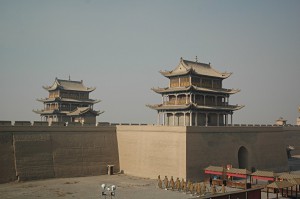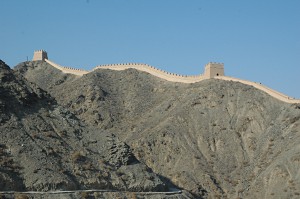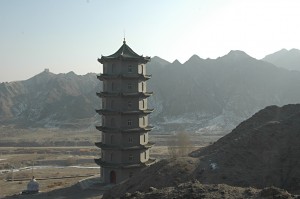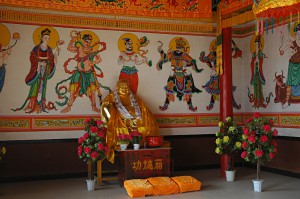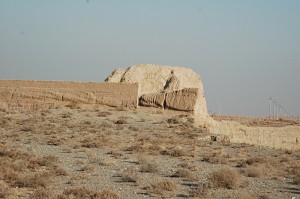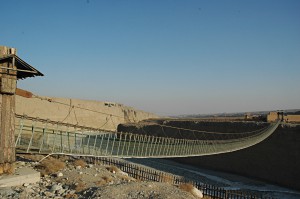After almost 2 weeks in the Xinjiang province, home of the Uyghurs, time had come to discover the second province in China. The first stop in the Gansu province was Jiayuguan, known for the western end of the Great Wall during the Ming dynasty.
After the tough trip from Turpan to Jiayuguan, Tim and I first needed an extended rest. Once we had checked in at the Lianshiju Guesthouse, we lay down for a nap. The nap took almost the whole afternoon.
Even though the experience of traveling with migrant works was once in a lifetime, we wanted to keep it that way. Once I had woken up, I first tried the train booking office next to the guest house to find information about the trains to Xining or Lanzhou. The office unfortunately had already closed at 4:30pm, such that I checked the bus station first. Even though we had the information that there was a night bus from Jiayuguan to Xining, the lady at the bus station knew nothing about it. Thus we decided to travel via Lanzhou.
The trip by bus would have been cheaper, but after my experiences with the Chinese sleeper buses from Hotan to Kuqa, I preferred the train. Tim and I double-checked the information together and he agreed to take whatever option I preferred. A young English-speaking Chinese told us which bus to get on to get to the train station. His western name was Michael (Jackson) who went the same way. On the bus we had a rather entertaining discussion, but after a while I started to wonder why the bus ride took so long. I asked Michael if this was the right bus for the train station and where we were. He then politely told me that we had already arrived in a neighboring city and that the bus was not going to the train station. He also let me know that I could get a taxi to the train station for 16RMB. I just laughed at him and told him that I would ride the same bus back to Jiayuguan. He then told me that I could have the ride for 10RMB. Probably his father or another relative or friend was the taxi driver. I still chose to take the bus.
The bus drove to the final stop where the driver had all the passengers get off, even the ones who had gotten on to ride to Jiayuguan. On some square in that city there was a queue of people who waited for a ride. A friendly man told me to queue as well and that a bus would be coming soon. Eventually an other bus arrived and I could get back on and ride back to Jiayuguan. Once I recognized the surroundings of Jiayuguan I asked another passenger how I could get to the train station. He told me to get off immediately and catch another bus. I thus got off and a lady at the bus stop indicated to me that I should catch a bus 1 in the opposite direction. This bus finally brought me to the train station, where I could buy the train ticket. The only problem i had this time was, that the lady at the counter did not read my written note carefully and thus had a wrong date in her computer. She told me, that I could not get the ticket I wanted. I wrote down the date two more times in different formats, but she still didn’t understand what was wrong. A lady in the queue helped out since she at least understood the word “tomorrow” such that I finally got the ticket I wanted, a bed in a 6-berth compartment.
On Thursday, when we had finally recovered from our stint on the night train from Turpan to Jiayuguan, Tim and I started visiting the tourist attractions of Jiayuguan. Our first destination was the fort. We rode comfortable there by bus where we were let go right in front of the tourist complex. Even though I should have become used to the increased prices compared to the guide book, which was published only a about a year ago, I kept being surprised at the raised prices of at least 20% for tourist sights and accomodation.
First we walked a small circle through the park in front of the fort before we walked across the lake straight to the fort. We walked straight up the hill to the fort, since we suspected an entrance at that place. Unfortunately there was only one entrance to the fort and that as on the opposite side.
The fort of Jiayuguan is the last fortress on the Great Wall to the west. A few kilometers down the wall there is a beacon platform where the wall ends at a canyon. The fort consists of many courtyards which are surrounded by tall walls connecting the courtyards through exactly one gate. One gets the impression that this fort was impregnable while in active use.
During good weather one should see the Hei Shan (black mountains) in and the Mazong Shan. As in other cities which I visited in China there was quite a bit of haze, such that the mountains were not visible. Once we had seen all the corners of the fort, we headed out of the fort to the nearby museum. The museum about the Great Wall first gives a general introduction before concentrating of the local aspects. This was a nice museum giving a better understand of the surrounding though models of the wall, the fort and other relevant constructions. I particularly found it interesting to learn that about one million soldiers were need to guard the whole wall during the Ming dynasty. Compared to today’s population of China this does not seem to be a lot, but considering that the Great Wall reached to Jiayuguan in the early 16th century this was quite a lot. Another interesting fact was, that the soldier were required to perform agricultural duties which not on guard. Thus the soldiers were farmers and the reserve for the guards at the same time. Their service was required such that the guards had food throughout the year. Two things which also could not missed to be noticed were the pictures of high ranking officials visiting the site and the museum shop through which one was led before exiting the the museum.
The ticket for the fort and the museum was at the same time a ticket for two more tourist sights: the overhanging wall and the first beacon platform. Unfortunately there was no public transport to those places, which were each about 7.5km from the fort in opposite directions. I asked a Chinese couple if they were going there and whether we could ride along, but they only shook their heads. We thus had no other option as to hire a taxi. The first driver initially wanted 16RMB to bring us to the overhanging wall, but once we sat in the taxi suddenly charged 60RMB to the wall and another 60RMB to the beacon platform. I guess he was not expecting that we get out of the taxi at this point. A second taxi driver had already offered to give us a ride first at 100RMB for both before decreasing his price to 90RMB when we walked off. Thus we went back to him and he brought us to the overhanging wall.
The overhanging wall got its name from the way it looks. Arriving at this piece of wall from the fort it looks as if somebody had hung it from the mountain. Once we were there we immediately set off to walk the wall up the mountain to the top, since on top there is, at least most of the times, a better view. The wall is very well maintained with the original materials. The light yellow tone of the wall contrasts really well with the black rock of the mountain it is built upon. Once we had reached the top, we were mildly disappointed. Since the top was also the end of the wall, which we had expected to continue across the mountains. Once we had taken all the pictures we wanted we started our descent, this time not following the wall but a footpath which gave a great view of the wall and the temples below. It was these temples we visited next. A friendly local with many missing teeth showed us all the temples there were. Finally we headed back to our taxi which brought us to the first beacon platform. This platform is nothing more than a big block at the end of the wall overlooking a nice canyon. Around this platform a touristic sight was established, such that there are sculptures of drunken brawlers and a few shops. A small hike is proposed leading across a nice hanging bridge to return back across the canyon by cable car. The cable car of course costs extra money, which is indicated nowhere. This taught me that the Chinese are not only communists but also capitalists. We did not spend the 31RMB on the cable car ride, but backed up the same way we had reached the bridge. The taxi driver then brought us back to Jiayuguan, where we went on discovery tour most importantly to find some food.
On the market in Jiayuguan we were convinced by a nice man to try his kebabs. At a stand opposite of his we were served some noodles, to renew our energy. We continued to walk the streets until it was time to head for the train station to reach our train to Lanzhou leaving at 9pm. At the train station we were approached by a few young Chinese who wanted to practice their English and where we had already been in China and where we wanted to go.
About 15 minures before departure we boarded the train, where we immediately found our compartment and our berths. We put away our luggage and lay down. Some of the locals unpacked a dinner and ate it before it was time, about an hour into the ride, to switch off the lights. About half an hour before arrival in Lanzhou the lights went back on and everybody packed their stuff.
It is always interesting to see how the Chinese are in a hurry and their wished have to be fulfilled immediately. For some Chinese it is impossible to wait for 2 minutes, before the chaos in front of him has cleared such that he can move to his or hear compartment on the train. As if driven magnetically, with quite a strong magnet, the Chinese are attracted to their goals directly without any deviations or compromises. However, every now and then there is an exception…
One more thing: today is New Years eve: to everybody who has followed this trip on-line I wish a very happy New Year! Even though it doesn’t always have to be the end of the year: I wish you much success in realizing your own ideas and the courage to take matters in your own hands.


